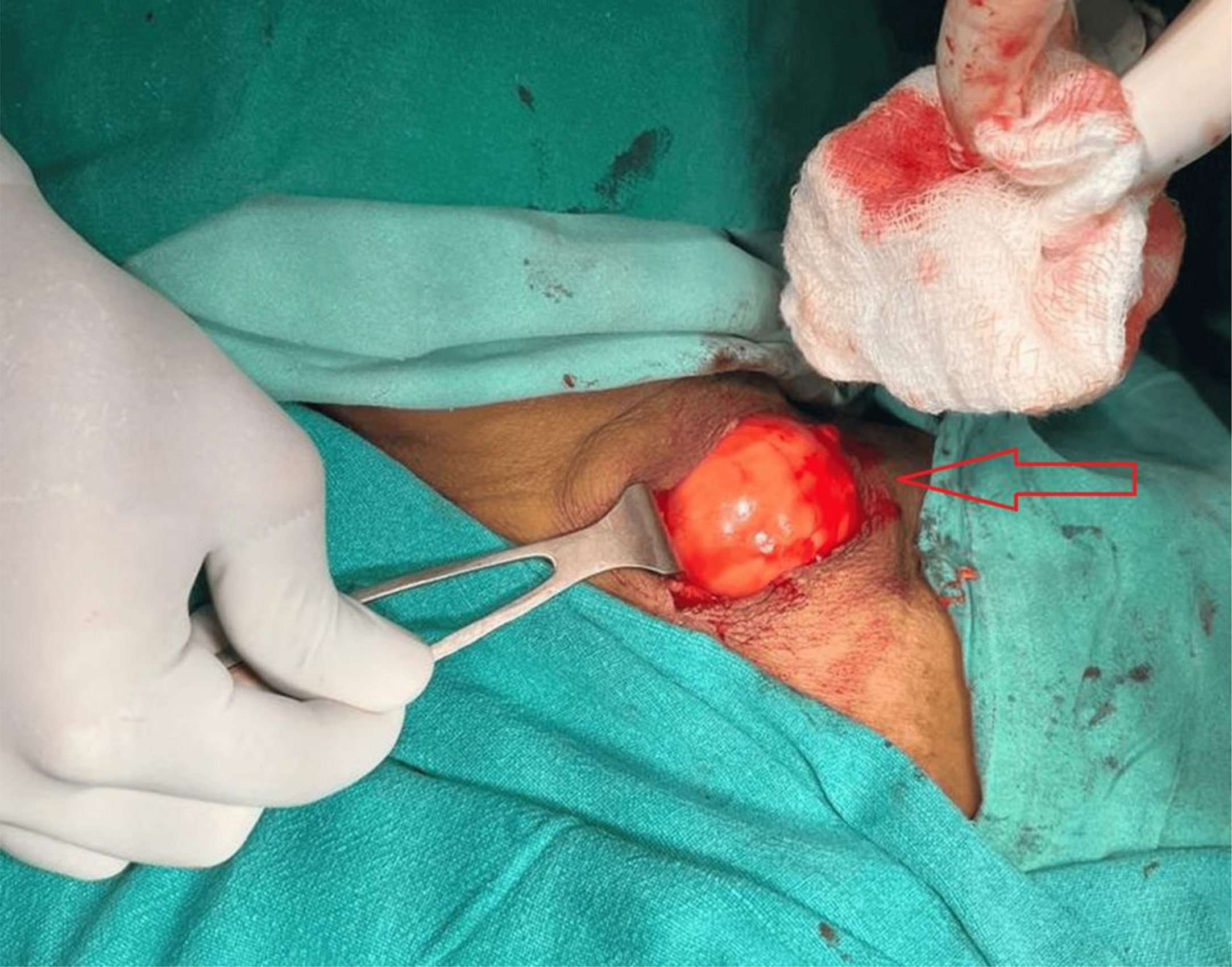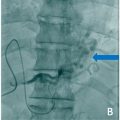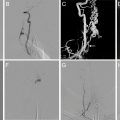Abstract
Spindle cell lipoma (SCL) represents an infrequent subtype of lipoma distinguished by its distinctive histopathological characteristics and tendency to localize in the subcutaneous tissues of the upper back, neck, and shoulder regions. In this report, we describe an unusual instance of SCL manifesting in the cervical area of a 62-year-old female individual. The patient exhibited a progressively enlarging painless mass situated in the left supraclavicular region for 8 years. Radiographic assessments disclosed a clearly demarcated, enclosed mass indicative of a lipomatous lesion. Microscopic analysis of the surgically removed specimen verified the presence of SCL, featuring mature adipocytes interspersed with spindle cells and collagen fibers. Subsequent immunohistochemical testing corroborated the diagnosis through the detection of CD34 positivity and S-100 protein negativity. Subsequent to surgical excision, the patient experienced an uneventful recovery period, devoid of any signs of recurrence throughout the monitoring phase. Despite its rarity, SCL should be contemplated in the differential diagnosis of neck masses, particularly when radiological findings point towards adipose tissue-related neoplasms. Timely identification and suitable intervention play a pivotal role in ensuring positive prognoses for individuals afflicted with SCL in the neck region
Introduction
Lipomas are the most common soft tissue tumors. Spindle cell lipoma (SCL) constituting a rare subset of benign fatty tumors, accounting for merely 1.5% of all adipose tumors [ ]. Initially SCL was documented by Enzinger in 1975 [ ].It typically manifests in the “Shawl area,” namely the subcutis of the posterior neck, upper back, and shoulder region. SCL primarily affects middle-aged males between 40 and 60 years [ ]. Male to female ratio of 10:1 was noted [ ]. The tumor is identified by the presence of mature adipocytes with small, uniform spindle cells. Clinically, SCL is well-defined, small, mobile, slow-growing, and painless subcutaneous mass, commonly presenting in a solitary form within the shawl distribution.
Microscopically, SCL has a distinct morphology characterized by spindle-shaped cells, adipocytic elements, scattered mast cells within a myxoid or collagenous matrix [ ]. Fascial and skeletal muscle involvement is a rare occurrence. Tumor diameters ranging from 1 to 14 cm, typically less than 5 cm is common. Treatment of choice involves simple excision, yielding an excellent prognosis. This is due to the absence of metastatic potential or reports of malignant transformation. The uniformly favorable prognosis underscores the preference for wide local excision as the optimal treatment approach [ ].
Case presentation
The 62-year-old female patient presented to sugery OPD with main complain of painless mass in the left supraclavicular region of the neck for last 8 years. Mass was gradually increasing in size since then. The patient did not have any complains associated with the mass like pain, difficulty swallowing, shortness of breath, or alterations in vocal quality. Her medical history included well-controlled hypertension. She had no prior surgeries and was not on any regular medications. There were no known drug or food allergies. Socially, she was a nonsmoker and nonalcoholic, with no history of occupational exposure to chemicals or radiation. Additionally, there was no family history of lipomas, malignancies, or hereditary connective tissue disorders. Laboratory investigations were within normal limits. The patient’s complete blood count (CBC) was done with a hemoglobin level of 13.2 g/dL (reference range: 12.0-15.5 g/dL), a white blood cell (WBC) count of 6.8 × 10⁹/L (normal range: 4.0-11.0 × 10⁹/L), and a platelet count of 280 × 10⁹/L (normal range: 150-450 × 10⁹/L). Renal function tests showed a blood urea nitrogen (BUN) level of 14 mg/dL (normal range: 7-20 mg/dL) and a creatinine level of 0.8 mg/dL (normal range: 0.6-1.2 mg/dL), indicating normal kidney function. Liver function tests were also within normal limits, with an aspartate aminotransferase (AST) level of 24 U/L (normal range: 10-40 U/L), an alanine aminotransferase (ALT) level of 22 U/L (normal range: 7-56 U/L), and an alkaline phosphatase (ALP) level of 80 U/L (normal range: 44-147 U/L). These laboratory findings suggest no abnormalities in hematologic, renal, or hepatic function.
During the physical examination, a palpable, painless, movable mass measuring around 5 cm in diameter was detected in the left supraclavicular region of the neck, as shown in Fig. 1 . The skin above it displayed no irregularities, such as inflammation or ulcers. No palpable lymph nodes were found on both sides of the neck. The rest of the head and neck examination yielded no significant findings.
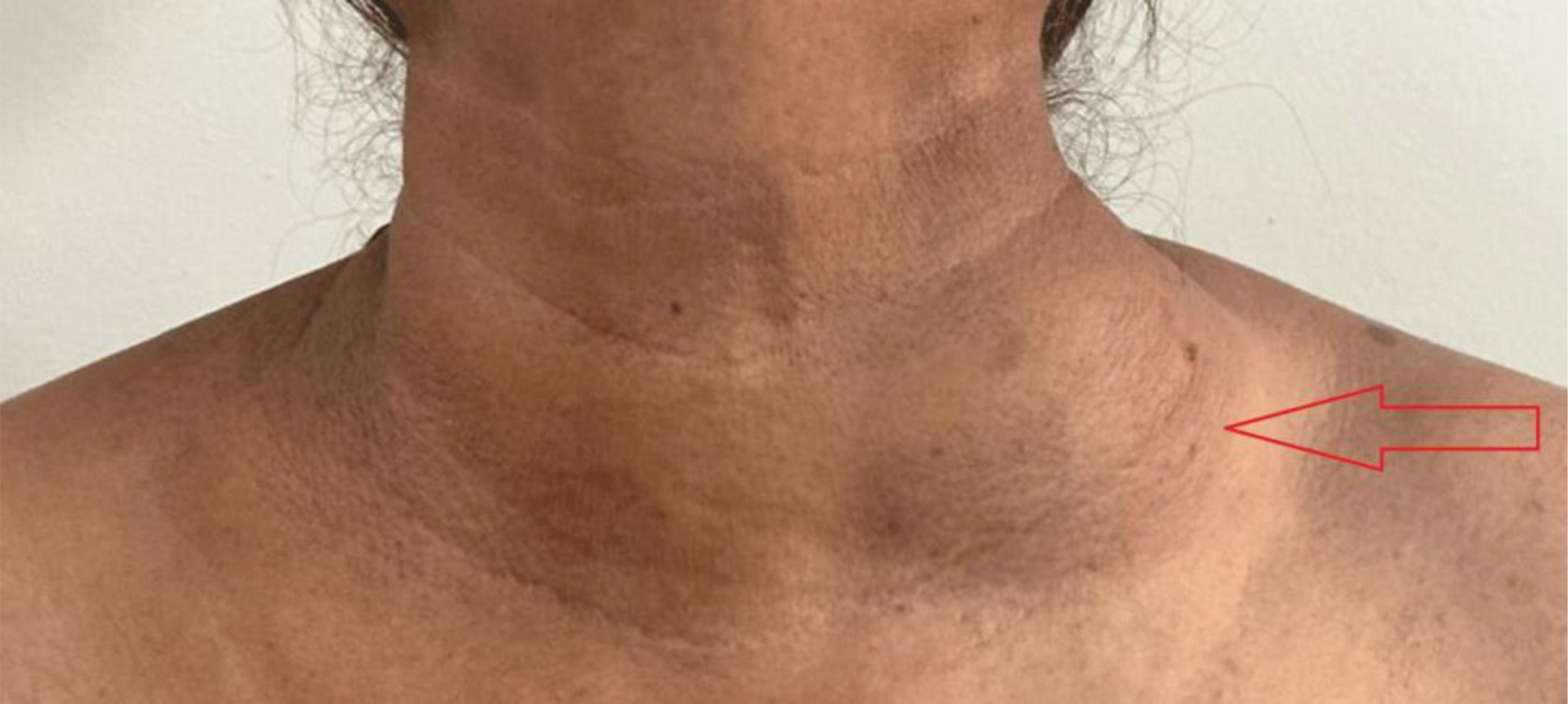
Diagnostic assessment involved imaging techniques and fine-needle aspiration cytology (FNAC). A contrast-enhanced computed tomography (CT) scan of the neck showed well defined hypodense fat density mass lesion (Hounsfield unit <−100) in the left posterior cervical region of the neck, as shown in Fig. 2 .It was measuring exactly 5.6 × 5 × 6 cm with few internal septations. The mass lesion was extending from C4 to D1 vertebral level. Anteriorly, it was abutting and displacing the left sternocleidomastoid muscle. Medially, it was abutting left paravertebral muscles and also abutting left internal jugular vein. The mass exhibited a uniform appearance with fat content, indicative of a lipomatous growth. Fine-needle aspiration cytology (FNAC) examination identified adipocytes and spindle-shaped cells, suggestive of a lipomatous tumor. Considering the clinical presentation, imaging results, and FNAC outcomes, a tentative diagnosis of spindle cell lipoma (SCL) was established.
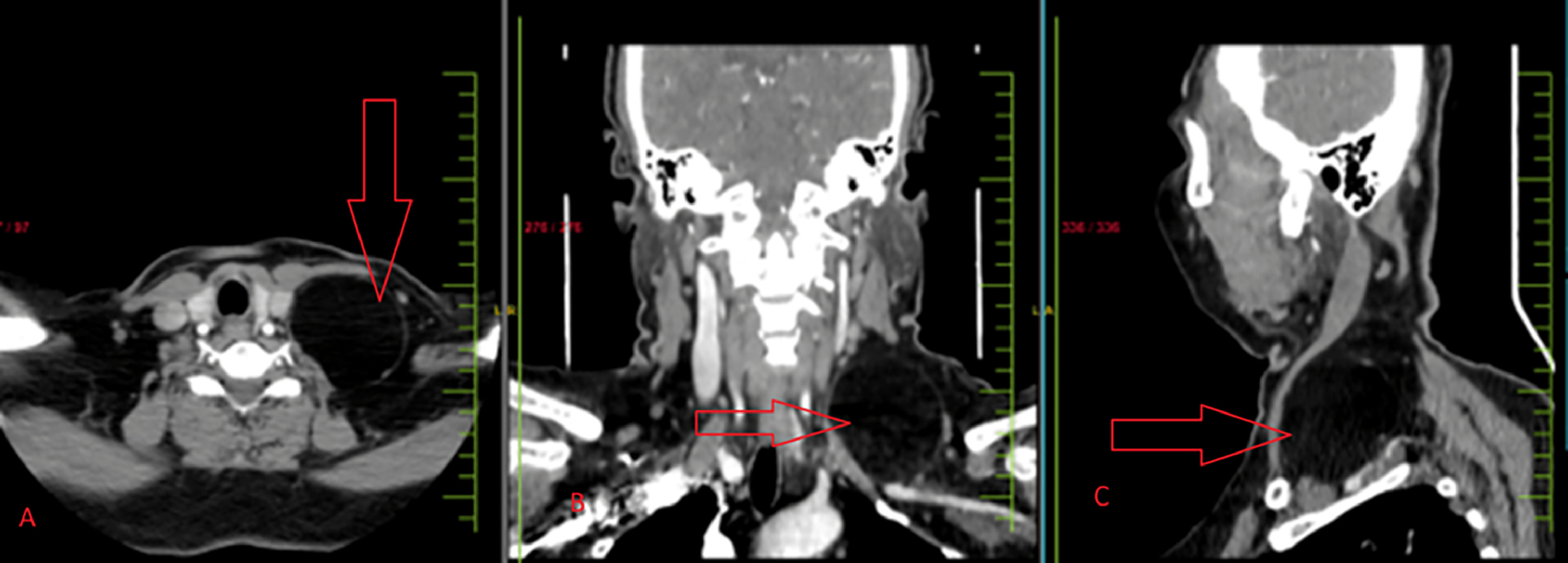
The patient underwent surgical removal of the neck mass under general anesthesia. Intraoperatively, the mass was observed to be well-contained and easily separable from neighbouring tissues, as shown in Fig. 3 . A visual inspection uncovered a rounded mass containing adipose tissue, as shown in Fig. 4 . The postoperative course was uneventful, with no complications such as hematoma, infection, or nerve injury. Sutures were removed within 7-10 days Subsequent to the histopathological analysis using hematoxylin and eosin stain, the excised specimen displayed mature adipocytes interspersed with spindle cells, confirming the diagnosis of spindle cell lipoma, as shown in Fig. 5 . Immunohistochemical testing indicated CD34 positivity and S-100 protein negativity, further corroborating the diagnosis.

